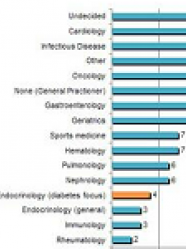Who Will Manage American Patients with Diabetes in the Near Future? A Grim Prognosis for the US

by dana m. lewis
The diabetes pandemic is exploding in populations worldwide regardless of gender, race, social status, or age. At the same time, the number of healthcare providers who specialize in diabetes is slowly and alarmingly dwindling. Previous studies have estimated that the US has a 12-15% undersupply of endocrinologists. Let’s think about this for a second: there are fewer than 3,000 endocrinologists practicing in the US but we have over 4,000 new patients diagnosed daily. The same studies predict the shortage to expand to nearly 30% by 20202, 3.
our diagnosis
We are proud to announce that diaTribe’s research into this question was selected for a poster presentation at this year’s ADA meeting (search for 864-P in Abstracts Online). We carried out a study to investigate why medical students were shying away from endocrinology, to identify what factors were deterring students from specializing in diabetes, and to determine what could be done to reverse this trend. Over five months, we sent out online surveys to medical school students across the US, yielding 524 participants (a response rate of 5-10%). All four years of medical school were represented with a small (39%) bias toward first year students.
Results confirmed that students were edging away from diabetes. While less than 1% of the students surveyed (only 4 students!) planned to specialize in or pursue diabetes care, over 25% of students reported having considered a career in diabetes care. This is comparable to other more popular subspecialties. Students cited the social importance and the pandemic status of the disease as the two most important factors that would attract them to diabetes. The difficulties in changing patient behavior and a lack of interest in endocrinology were the two main deterrents.
Regarding students’ exposure to the disease during medical school, diaTribe found that 36% had “a little” exposure; 30.6% said they had “some” exposure; and 6.9% reported having “a lot” of exposure. Fewer than 27% had no exposure to diabetes; most of these were first year students.
our prognosis
The diaTribe survey suggested that fewer and fewer medical school students are planning to specialize in endocrinology. So where do patients with diabetes go? To primary care providers! As students recognize that changing patient behavior is time consuming – and lies at the core of diabetes care – they also realize that treating patients with diabetes at current reimbursement levels is not necessarily lucrative. The result: fewer healthcare professionals who can treat patients with diabetes as a specialty, a future of more diabetes complications, and a future of dwindling health (and productivity) for the US. Our prescription
Increasing physician interest in diabetes will require significant changes in reimbursement for physicians’ services and the services of diabetes educators, whom the endocrinologists love, but sometimes can’t afford to pay. Maybe persuading more insurers to pay for phone and email consultations is a start? What about incentives for practices able to achieve suitable health targets for a percentage of their patients? These may not be perfect but could be a step in the right direction. Improved therapies providing alternatives to behavior modification could also increase interest in diabetes. Most importantly, patients should play a part in improving the trend. An engaged patient allows for a much smoother consultation during which both patients and physicians benefit from each other’s expertise.
We look forward to a larger study focusing more on senior medical students and internal medicine experts to provide information about trends in the perception of diabetes throughout a medical education.
The future would be bleak for people with diabetes without diabetes specialists. Let’s issue a call to action for patients to assume more of the reimbursement battle and to increase the interest of medical students in becoming stakeholders in the future of diabetes!
1 Who Will Manage American Patients with Diabetes in the Near Future?” Kelly L. Close, Mark Yarchoan, Katelyn L. Gamson, Jenny J. Jin, Dan A. Belkin, Michael L. Dougan, and Irl B. Hirsch, MD
2 Stewart, A. F. The United States Endocrinology Workforce: A Supply-Demand Mismatch. J. Clin. Endocrinol. Metab., April 1, 2008; 93(4): 1164 – 1166.
3 Erikson, C. et al. Future Supply and Demand for Oncologists: Challenges to Assuring Access to Oncology Services. J. Oncol. Pract, March 1, 2007; 3(2):79-86.

.JPG)
.JPG)






